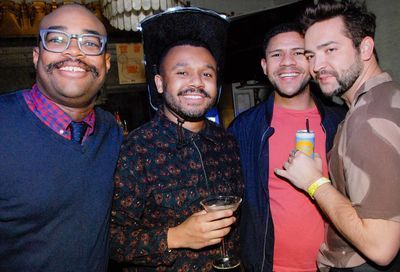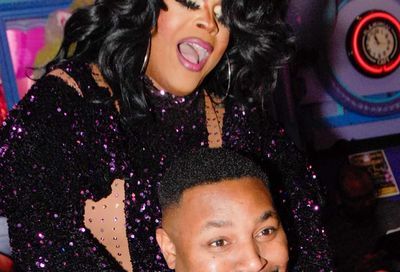Poetry in Motion
'Howl' takes a fully artistic approach to the infamous poem, while 'Hornet's Nest' never really amounts to very much
Howl is a piece of art.
The statement is true for both the poem by Allen Ginsberg and the film from co-directors Rob Epstein and Jeffrey Friedman (The Celluloid Closet). If referring to the poem, it’s because Howl gave definition to the Beat Generation; if referring to the film, it’s because it resembles an art project where the artists are trying to show off every technique they ever learned.

A different beat: James Franco in ‘Howl’
When published in 1956 by Lawrence Ferlinghetti’s City Lights Books, Howl became a sensation. Ironically, in addition to the work’s literary merit, the charges brought against Ferlinghetti and the subsequent obscenity trial were just about the best publicity that the poem could have received. Epstein and Friedman’s film paints the trial in an absurdist light and gives renewed life to Ginsberg’s words. But if not for the casting of James Franco as Ginsberg, the words on the page might have never taken flight.
Howl is broken into several sections, each designed to capture a different aspect of Ginsberg’s poem. In one part, Franco plays Ginsberg reading the poem aloud to an audience of enthralled and constantly nodding peers. In another, he’s speaking with an interviewer while skipping the obscenity trial. In yet another section, Franco’s voiceover of the poem is set to animation. And finally, the actual trial is enacted.
It’s this structure that causes Howl to feel like a thesis rather than a film. One part animation, one part black-and-white, one part courtroom drama, and one part documentary — it’s an exercise in cinematic genres all jumbled into one film. That’s not to say that each part doesn’t succeed at times, but never enough and rarely in complete harmony with the other sections.
The directors should be recognized for their ability to provide context for the poem and demonstrate the source of certain sections, whether it be a friend or an experience. But in doing so, they sometimes repeat sections of the poem multiple times, and the repetition transforms the zen-like state that Franco’s voice provides into a ”this again?” moment.
Franco truly embodies the role and the film is a showcase for his talents. Adopting Ginsberg’s speech patterns and hiding behind the thick accent and distinctive glasses, Franco gives weight and meaning to the words as if they were actually his own. Seldom required to interact with other others, Franco transforms a blank slate into a beautifully painted portrait of the artist as a younger man.



Starring James Franco
Not rated
90 Minutes
Opens Oct. 29
West End Theatre
2301 M St. NW
In addition to Franco, a number of noteworthy stars populate the courtroom for the trial, all crammed into the one section that contains interactive dialogue. As the defense attorney, Mad Men‘s Jon Hamm looks overly polished as he defends the poem’s literary merits, carrying off a smug and confident air that conveys the filmmakers’ position that the proceedings are ridiculous. On the other side of the aisle, David Strathairn is the prosecutor, grilling his witnesses as to the meanings of certain lines, which sound crude and coarse coming from his mouth. The most ridiculous portrayal is Mary-Louise Parker’s conservative Gail Potter, who denounces the poem with great enthusiasm. Parker plays the part for laughs, diminishing the fervor behind her position.
While the film strives too hard in its varied presentation of Ginsberg’s story, perhaps the thing it does best is inspire one to pick up the poem and read it again. Because not enjoying Ginsberg’s writing may just be the thing that’s most obscene.
IT SEEMED THAT Stieg Larsson’s Millennium trilogy (The Girl with the Dragon Tattoo, et al.) was required reading this summer. And it may be for anyone interested in finishing the Swedish film trilogy with The Girl Who Kicked the Hornet’s Nest.
Those who haven’t seen the prior two films, the fantastic Dragon Tattoo and the serviceable The Girl Who Played with Fire, need not even bother with the final installment. Only the barest of back-stories is provided, and even those familiar with the films might get confused trying to remember which old, white Swedish man is which.
After being raped, framed, shot and countless other atrocities, it’s finally time for Lisbeth Salander (Noomi Rapace) to seek revenge. Unfortunately, convalescing in a bed means there is little for Salander to actually do, and the whole movie suffers for it. As her knight riding in to save the day, Mikael Blomkvist (Michael Nyqvist) gets a little more action, but it’s not enough to overcome the plot-heavy conspiracy story.


Rated R
148 Minutes
Opens Oct. 29
Area Theaters
While the final book in the trilogy exploded the story tenfold from the almost standalone Dragon Tattoo, cramming decades of build up into two-and-a-half hours was an almost impossible task for director Daniel Alfredson. He manages to capture the highlights and include just enough of the book’s most satisfying moments to bring Salander’s story full circle, but the plot loses steam way too quickly. The film’s saving grace is the title character, the indomitable Lisbeth Salander, who is embodied so completely by Rapace that it’s nearly impossible to imagine anyone else in the role (hear that Rooney Mara?). Even bedridden, Rapace’s performance is excellent as she continues to make Salander both an enigma and a hero.
While there’s satisfaction in seeing the story come to a close, the film’s disappointing send-off makes one all the more curious to see if the American versions translate well and can live up to or – dare to dream – exceed the Swedish originals.
Support Metro Weekly’s Journalism
These are challenging times for news organizations. And yet it’s crucial we stay active and provide vital resources and information to both our local readers and the world. So won’t you please take a moment and consider supporting Metro Weekly with a membership? For as little as $5 a month, you can help ensure Metro Weekly magazine and MetroWeekly.com remain free, viable resources as we provide the best, most diverse, culturally-resonant LGBTQ coverage in both the D.C. region and around the world. Memberships come with exclusive perks and discounts, your own personal digital delivery of each week’s magazine (and an archive), access to our Member's Lounge when it launches this fall, and exclusive members-only items like Metro Weekly Membership Mugs and Tote Bags! Check out all our membership levels here and please join us today!





















